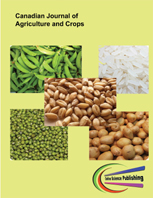The Effect of Water Stress on Total-Phenolic Content of Barley
DOI:
https://doi.org/10.20448/803.6.1.1.9Keywords:
Barley, Maturation, Phonological stages, Total-phenolics, Water deficit.Abstract
Little is known about the relation between water stress and the accumulation of phenolics in plant tissues. The present study aimed to investigate the effect of water stress and maturation on the production of total-phenolics (TP) by four barley (Hordeum vulgare L.) varieties (‘Manel’, ‘Martin’, ‘Rihane’, ‘Espérance’). During three phenological stages (S-8, S-10.5, S-11), following Feekes scale, whole barley plants were pulled out of the field and separated into roots, stems, and leaves. Water extracts were prepared from plant parts and their TP contents were determined by spectrophotometer. To determine periods of water deficit (WD) at field, climatic characterization of the region was carried out. TP accumulated in barley plant and its parts under the influence of water deficit essentially at S8, which coincided with barley spring growth. However, TP content decreased when WD became more pronounced at the following stages. This response may be explained, partially by the biosynthesis of lignin from free phenols when the plant approached maturity. Results suggest that water stress stimulates the synthesis and accumulation of TP in barley tissues during active growth periods (spring growth) at S-8. This response doesn’t persist until the critical periods of WD where barley maturity favors a decrease in TP content for all plant parts. Regardless of growth stage and WD, barley accumulates preferentially phenolics in above-ground plant parts. The evolution of phenolic accumulation under water stress showed the same trends for the tested barley varieties, indicating a genetic control of phenolic production and their partitioning across plant parts.


